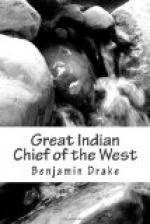“Most of the dancers were the principal warriors of the nation—men who had not condescended to amuse themselves or others, in this manner, for years before. But they now appeared in honor of the occasion, and to conciliate, in their best manner, the good will of the representative of the government of the Big Knives. Amongst these veteran warriors, Ietan, or Sha-mon-e-kus-see, Ha-she-a (the Broken Arm), commonly called Cut Nose, and Wa-sa-ha-zing-ga (or Little Black Bear), three youthful leaders, in particular, attracted our attention. In consequence of having been appointed soldiers on this occasion, to preserve order, they were painted entirely black. The countenance of the first indicated much wit, and had, in its expression, something of the character of that of Voltaire. He frequently excited the mirth of those about him, by his remarks and gestures. Ha-she-a, (called Cut Nose, in consequence of having lost the tip of his nose, in a quarrel with Ietan,) wore a handsome robe of white wolf skin, with an appendage behind him, called a crow. This singular decoration is a large cushion, made of the skin of a crow, stuffed with any light material, and variously ornamented. It has two decorated sticks, projecting from it upward, and a pendent one beneath; this apparatus is secured upon the buttocks by a girdle passing round the body. The other actors in the scene were decorated with paints of several colors, fantastically disposed upon their persons. Several were painted with white clay, which had the appearance of being grooved in many places. This grooved appearance is given by drawing the finger-nails over the part, so as to remove the pigment from thence in parallel lines. These lines are either rectilinear, undulated, or zigzag; sometimes passing over the forehead transversely, or vertically; sometimes in the same direction, or obliquely over the whole visage, or upon the breast, arms, &c. Many were painted with red clay, in which the same lines appeared. A number of them had the representation of a black hand, with outspread fingers, on different parts of the body, strongly contrasting with the principal color with which the body was overspread; the hand was depicted in different positions upon the face, breast, and back. The face of others was colored, one half black, and one half white, or red and white, &c. Many colored their hair with red clay, but the eye-lids and base of the ears were generally tinged with vermilion.
“At the conclusion of the ceremony, whiskey—which they always expect on similar occasions—was produced, and a small portion was given to each. The principal Chiefs of the different nations who had remained passive spectators of the scene, now directed their people to return to their camp. The word of the Chiefs was obeyed, excepting by a few of the Ioways, who appeared to be determined to keep their places, notwithstanding the reiterated command of the Chiefs. Ietan now sprang towards them, with an expression of much ferocity in his countenance, and it is probable a tragic scene would have been displayed, had not the chiefs requested him to use gentle means; and thus he succeeded; after which, the Chiefs withdrew.”




